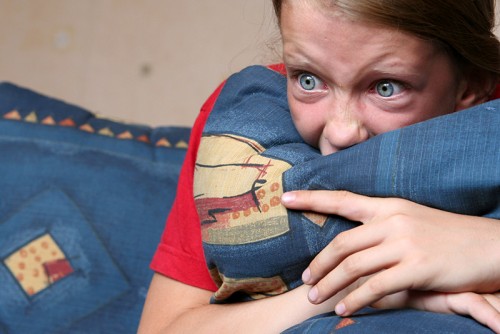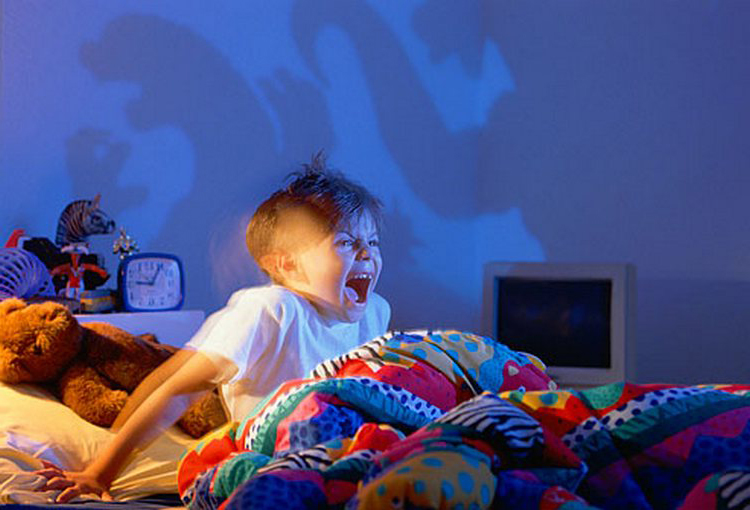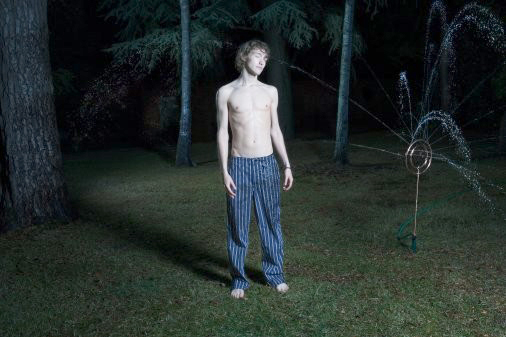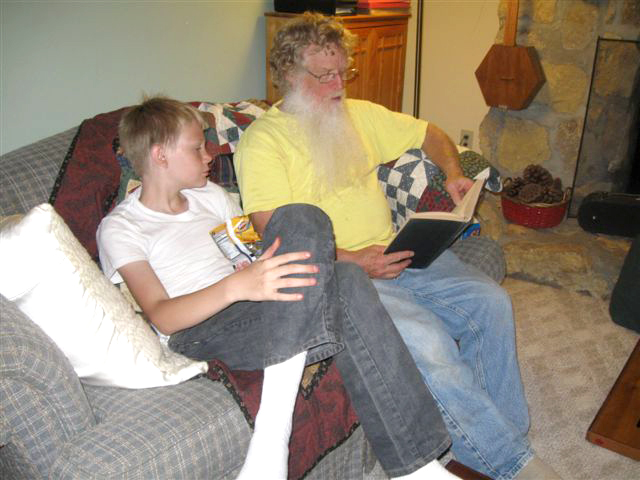Night Terrors and Nightmares
Do you think that the term “Night Terrors” is just the name your grandmother used to describe an upsetting bad dream or nightmare?
Well, I never met your grandmother so I don’t know really know what she meant; BUT, they are not the same thing and are treated somewhat differently.
11 year old girl with night terrors (sleep terrors)
However, let’s not be too though on granny because she isn’t the only one who doesn’t seem to have a clue that they are two different things – just peruse the “so-called” experts on the internet trying to sell you something.
Absolutely anyone who has had a child with real night terrors, also known as sleep terrors, has no trouble at all telling them apart. A child with a nightmare may come into your room at night and tell you they had a bad dream; a child with night terrors tends to summon the whole household into their room without knowing they’ve done it.
Sleep and Parasomnias
Sleep is a funny thing – unless someone doesn’t get it, and you’re the one who’s not getting it. It occurs when… well… when you’re asleep so you don’t know what’s going on or why. And we know very little about it, except that we’ve got quite a list of things that can go wrong.
The “somnias” are categorized into “Dyssomnias” – characterized by a disturbance in the amount, quality, or timing of sleep; and, “Parasomnias” – those involving abnormal movements, behaviors, emotions, perceptions and dreams while trying to sleep.
The former are things like: sleep apnea, narcolepsy and sleep hygiene issues; the latter: restless leg syndrome, sleepwalking and sleep terrors. Notice “nightmares” aren’t classified, medically-speaking, as abnormal sleep.
One of the few things we do now realize about sleep is that it is the time when a lot of critical brain hygiene occurs, absolutely essential for proper functioning of the nervous system. All of the day’s short-term memories are consolidated into long-term associations and memories, neurological compounds are regenerated for nerve functioning and the millions of tiny nerves have a chance to grow and connect with each other.
All that cellular hustle and bustle is the: Stuff that dreams are made of!
Nightmares
We do also know that sleeping consists of several cycles of transitions between lighter and deeper sleep which can be easily measured on “brain wave” testing (EEG).
In one of the later transitions from deeper to lighter sleep the eyes start to move rapidly under the eyelids, as if the person is watching something while they are asleep, and that is where dreams occur – whether or not you can remember them.
This REM sleep (Rapid Eye Movement) sleep is also where “bad dreams,” known as nightmares occur.
Nightmares (those that are remembered on awakening) occur in about 10-15% of children, boys and girls equally, and of any age but more frequently between 3 to 6.
REM sleep is a lighter sleep and doesn’t occur until after at least one cycle of deep sleep. During it, all muscle contraction is inhibited (shut off) so the child often awakens with memory of the “dream” but does not thrash about or vocalize.
Content of dreams is age-related: Toddlers/preschoolers – separation; 7 to 9 – monsters or the dark; and, 10 to 12 – death, kidnapping or real dangers. Other common themes are loss of control or fear of injury.
Therefore, general features of nightmares include: 1 – occur 90 or so minutes after falling asleep, at the end of a deep-sleep cycle; 2 – no to minimal limb movement; 3 – awaken mostly aware of surroundings with ability to be comforted; and, 4 – increased during stress or family difficulties.
Night Terrors
Night Terrors (AKA Sleep Terrors, Pavor nocturnus) are quite a bit different, both in display, timing and probably etiology (cause). They do NOT occur within REM sleep, they occur before it during the final portion of a deep-sleep cycle which is often between 15 to 90 minutes after falling asleep.
They can begin as early as 18 months of age and usually resolve in adolescence, although the peak ages are 5 to 7 years of age. About 3 – 5% of the population has them, more in boys and those children who have a family history of the problem.
Because it is not in REM sleep, where the muscles are inhibited, the child appears agitated with facial expressions and vocalizations that convey fear. They can strike out and thrash with all the signs of intense activity such as sweating, heart rate, rapid breathing and dilated pupils.
They appear wide awake but they are not — and usually completely forget anything about the episode after they easily fall back asleep in about 5 to 10 minutes – although they may be the only one in the household who is asleep when it’s over.
Episodes of night terrors often occur several nights in a row then subside for a while. If one tries to awaken the child (not a good idea) they are unresponsive and incredibly difficult to respond.
Most often no specific trigger can be found although fevers, stress, sleep deprivation and some drugs (sedatives, antihistamines, etc.) seem to increase the frequency in a prone individual.
There is an additional issue with night terrors – they are associated with sleep-walking about 18-33% of the time; which means that precaution should be taken to keep them in their room and awaken parents should it occur.
Can Anything Help?
Well “time” is the common denominator for treatment of both issues. There are a few things however that pediatricians spend some time talking about during the visit.
Nightmares
Even though we don’t really know what triggers nightmares, we know that they are increased in times of stress so there is the first step: try and identify, in the daytime, what might have changed or be increasing the stress of a child that age. Then take steps to remove it in the daytime.
One wants to comfort and reassure a child with nightmares but the parent’s reaction can, and often does, actually increase bedtime difficulties by validating their fears or reinforcing inappropriate behaviors. Reassurance can be given for a few moments before going back to their own bed to sleep.
And, I have to say that play-searching for monsters just validates a preschoolers fears that there are in-fact monsters – just not in the closet at the moment.
You don’t want to close the door on a fearful-child, so leave it ajar; and a “security blanket” doesn’t hurt anything.
Discuss the bad dream the next day only IF the child brings it up; and then only non-nonchalantly as something that wasn’t there or won’t come true and as a phenomenon that most everyone has at some time in their life but goes away – which it does around 10 or 11, perhaps owing to neurologic maturation and reduction in separation anxiety.
It should go without saying that pre-bedtime rituals should be full of calm, happy and “good things happening tomorrow” type thoughts; and that they should be protected from seeing or hearing violent or frightening movies and television (in short pretty much everything that stations produce these days).
Bring frequent nightmares up at your next well-child visit and seek more advice if they seem to be increasing in frequency, becoming worse, interfering with daytime activities or you simply have other concerns or questions.
Night Terrors
Probably the most disturbing aspect of having a child who is going through a night terror is that even though they appear completely awake and fearful, they aren’t and they do not respond to any of your attempts at consolation.
If you really want to help, merely stand and observe that they don’t hurt themselves without adding your own fear issues into the already stressful situation. As the episode subsides they may become more responsive to a calming voice; or, they just may go to sleep.
Trying to touch, hold or restrain the child is likely unhelpful and may make matters worse by prolonging the episode. If a trial of light contact doesn’t seem to hurt, lightly holding the child may make things easier for you as long as you aren’t transmitting your own panic or stress.
Once the worse is over you might want to feel for a fever or take their temperature because occasionally an illness or fever is thought to act as a trigger for night terrors in a child prone to them. It might give you a heads-up to catch a developing illness early.
Like with nightmares, a child with night terrors seems to be effected by stress and being over-tired. Realizing that it might only help a little, it just makes common sense to make extra attempts to do what is possible to squash stress, keep things calm and maintain routines including bedtimes – especially during periods of nightly episodes. And, it should go without saying, that it’s best not to sleep away from home until they subside.
Occasionally it is thought that something awakening the child during a deep sleep might act as a trigger for an episode. Just make sure that the room isn’t being subjected to excess external sound or light. Paying attention to what happens immediately prior to episodes of night terror might help determine any contributing factors.
Trying to force a child having a night terror to wake up is not a good idea and is likely to leave them confused and disoriented thereby increasing stress and feelings of helplessness. A comforting thought for a parent is that the child is unlikely to even remember anything about it the next day.
Finally, make sure and prepare babysitters or other care-givers for these episodes and explain how to handle them.
Once the diagnosis has been made and a thorough physical exam done by your pediatrician to rule out other possible diagnoses, it’s pretty much a matter of doing what you can to minimize the occurrences and keeping them safe during episodes. There are some medications we occasionally try if things become intolerable but they aren’t without side effects so aren’t used routinely.
Consult your pediatrician if you notice any of the following:
- The child has drooling, jerking, or stiffening
- Terrors are interrupting sleep on a regular basis
- Terrors last longer than 30 minutes
- Your child does something dangerous during an episode
- Other symptoms occur with the night terrors
- Your child has daytime fears
- You feel family stress may be a factor
- You have other questions or concerns about your child’s night terrors
Advertisement by Google
(sorry, only few pages have ads)




